Through reflective kindergarten self assessment practices, young children can design and accomplish life-changing student led conferences for their parents. The power of reflecting on our past coupled with creating goals for the future transformed and invigorated my classroom. For more than 20 years, I worked alongside almost 500 youngsters as they uniquely planned for their families.
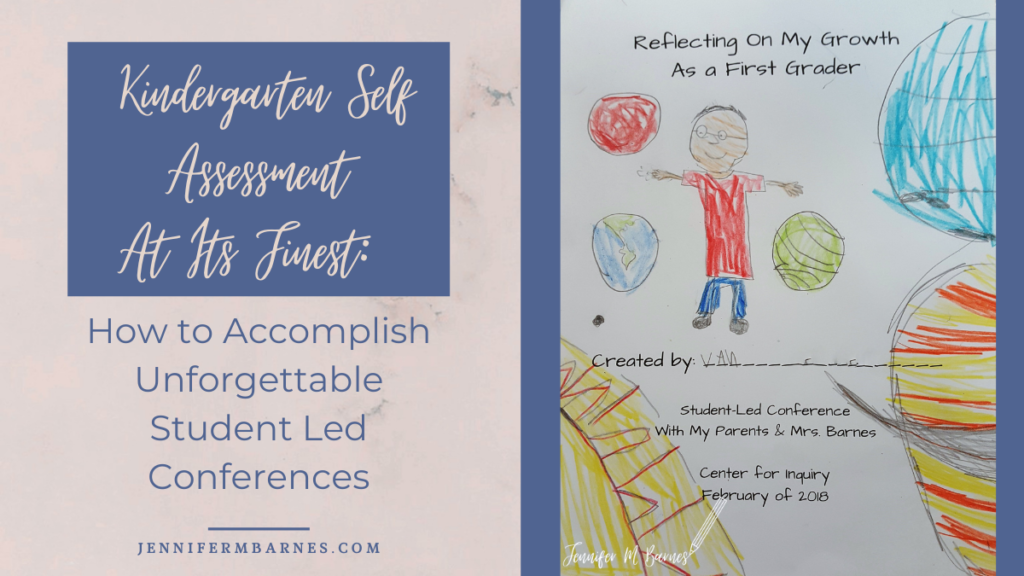
If you’d like to view a one-minute movie
highlighting this most significant practice in my teaching, please click below.
(Please note that this video was originally made for Dr. Heidi Mills’ Inquiry Matters Conference in Columbia, South Carolina, in 2020.)
If you’d like to see how it all begins with reflecting and strategies for capturing children’s documentation, check out my last post on The #1 Surprising Truth About Amazing Student-Led Parent Teacher Conferences
This new post picks up where that one stopped: looking critically at self assessment and setting goals for the big conference day.
Fishbowl Demonstration: A Kindergarten Self Assessment on Display
After all the days of writing and sketching, many times little children feel like they’re “done.” This next component is critical for them to understand that this is a process. They will observe one of their friends pretending to host a student-led conference with the teacher, see the need for gathering resources, and prepare to share with others.
Choosing just the right assistant is extremely important.
I never want to discourage children. Therefore, this child/assistant should not have the neatest writing or “best work” in the classroom. If a child’s work looks “too perfect,” others might believe their own work would never measure up. Instead, pick a child who is:
- a bit messier,
- a bit more thrown-together,
- but, one who can articulate ideas as you pose reflective questions.
Classroom Setup for the Fishbowl Demonstration
To make the most of the kindergarten self assessment, rearrange the main circle so that the child/assistant and I will sit in the middle in chairs with the child/assistant’s writings and drawings in full view. To everyone’s amusement, I’ll pretend to be the “mommy” and ask what they’ve written and drawn. As that child talks, we’ll work together to negotiate thoughtful answers to questions and highlight things all the children should be considering.
The best kindergarten self assessment begins with questions!
When choosing Writing Workshop pieces, talk about:
- Hey! Where is your best writing? Could you share that?
- What makes it the best writing piece thus far?
- Is there one you could get that was earlier (or different or less pulled together) to showcase the differences for your parents to see how you have changed?
When brainstorming science and math artifacts, reflect on:
- What science sketch is the one you learned from the most? Let’s tab that with a post-it note so you can find it quickly to show during the real conference.
- You say you’ve become better at skip-counting. Which math area helped you understand it more? Could you get that to show your parents, too?
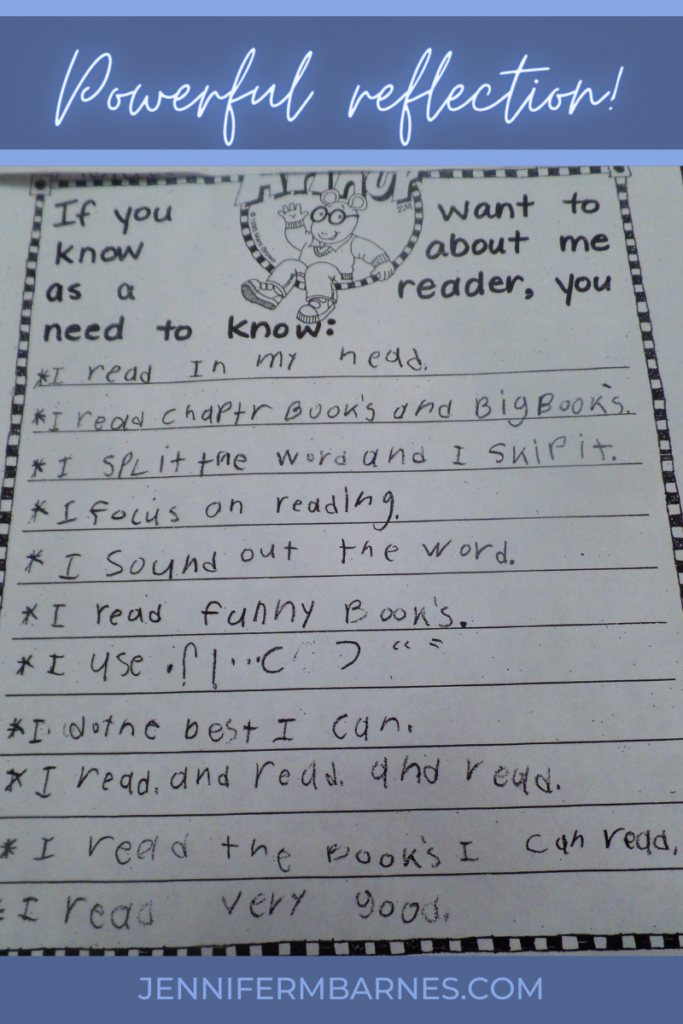
When talking about yourself as a reader, highlight:
- The kindergarten self assessment documents already done.
- A book that was a good match at the beginning of the year (like an emergent Big Book) compared to a book that is more appropriately matched all these months later. Just look at the difference!
This Fishbowl Conversation highlights several big ideas:
- All our writing and drawing is important – and we are in the process of sharing it with the most important people in our lives. (“We’re not done yet!”)
- We each will share this information with our parents and teacher – although this is something we’ve never done before! We want to make it the best experience possible.
- Just like our friend/assistant is using drawings and writings – and now artifacts, we’ll each need to gather thoughtful artifacts as well. We need to think now about which ones might be best to show for our evidence.
- Even more importantly, the child/assistant and “his mom” are having a conversation! They both are talking, listening, thinking, and explaining “from their hearts” about themselves as learners. We need to be thinking now about particular words we might use that can describe how we have grown and changed, too.
Pro tip for Teacher Self Assessment
It’s critical for teachers to watch their own vocabulary in this scenario. Stay away from words like “the best/worst, the prettiest/ugliest.” Use phrases more like “what I learned from most” or “how my writing has changed.” It’s worth noting that from the beginning of the year, we seek to choose our words wisely. So this language has become more natural and routine for the children.
Gathering of Resources (Writing Workshop):
Once the children have seen the fishbowl demonstration, they’ll understand the purpose of pulling their own resources substantiating their reflections.
The Teacher’s Role In Gathering Work Samples
Yes, you as the teacher will be integral to the children collecting their items, tabbing them with post-it notes, putting them in a special area so they’ll be ready to practice. (This is a really messy, but an amazingly-constructive and positive experience!)
Critical Conversations Ongoing
For the kids who see things and think how “awful” they imagine they look:
- We can have powerful conversations. “Look how much you’ve grown! That’s amazing! Aren’t you proud of yourself this year?”
For the kids who are shocked over the size differences in their handwriting:
- We showcase some of their earlier writing pieces and how large they used to write compared to their (hopefully!) more neat, smaller writing now.
- We compare their earlier sketches to their more detailed, thoughtful, later ones – not that one is “prettier/better,” but that it clearly shows maturity in the writing process.
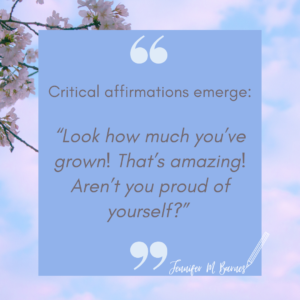
Needed: Vigilance of Teachers!
- Distribute post-it notes, reteaching how to securely tab the important comparative pages so their parents can be just as amazed as they were.
- Keep your eye on those trash cans. Lots of times, little kids will head to wastebaskets with evidence galore!
- Take a mental note, too. If a child has an abundance of Writing Workshop booklets not completed beyond the first page or so, that might trigger a new goal for the remainder of the year. 🙂
Want More Information beyond Kindergarten Self Assessment?
I was thrilled to have my insightful colleague, Susanne Pender, chat on our first grade podcast, Kidtalk. In her first episode, she shares how she helps her 2nd and 3rd grade children as they reflect across the year and design student-led conferences for their parents. Just click here for her first episode on Student-Led Conferences:
Kidtalk Episode 6- Student Led Conferences (podbean.com)
Susanne returned for a second episode, sharing all the ways she equips her older kids in preparing and pulling off these student-led conferences of their own.
Click here for that second episode: Kidtalk Episode 7 – Student Led Conferences, Part 2 (podbean.com)
Practice Days:
Every child must practice presenting – both individually with you and to their “parents.” (Hopefully, some 5th grade buddies or their own classmates can roleplay being their parents.) First, I borrow time from our daily independent reading time to conference individually with every single child. Basically, they review their documentation quickly with me, sharing their words, drawings, and thoughts. I take the most thorough notes possible in my own notebook. It’s critical for me to know the big ideas each one plans to share just in case they get nervous on the big day.
On the morning of the main practice day, during our Reading Workshop time, each child has their plans and resources in front of them as we spread throughout our classroom. Each child would practice the Science Section first, all of us choral reading through the main prompt. Next they’d continue reading their individual piece of that section quietly, recalling what their responses would be. Then we’d continue with each subject area, sing-songing their main prompt and quietly filling in their individual pieces. Once we finish, they all sigh deeply, realizing what a big project we all managed to pull off!
During the remainder of the independent reading time, they could practice one last time what they were going to share with their buddies. It would also be a good time to ask me if they had any concerns, forgot any main ideas, etc. At this point, too, if a child has too little information or has lost something, it does become more apparent. And you’ve got a bit of time to help that child pull some things together!
The Best Part of The Practice Day
The most exciting part of the day though is when the 5th grade buddies show up. The little kids are ecstatic to welcome their “moms and dads” to their very first student led conferences! And, yes, it truly feels like a celebration.
Instead of choral-reading as we had practiced earlier, the buddies partner up in their own private space, heads together. The kindergartners bashfully, yet excitedly begin hosting their conference with their sing-song phrase, “If you want to know about me as a scientist…” Their “parents” nod and lean in, ask clarifying questions and help them find an artifact or two. Essentially, they boost them up and cheer them on. We teachers are thrilled to immerse ourselves in the midst of twenty-two simultaneous individual conferences going on all around us.
Although I always dearly loved this moment and truly thought it was critical in preparing my little kids, I worried that it was one-sided. I knew that their interactions with us would be invaluable time invested in my children’s confidence with the whole experience, something I could never give each child. But I worried that we might have wasted a bit of their class work time.
However, my unforgettable colleague, Amanda Mahowald Blake, shared with me how powerful it was for her own older students to see the experience through the perspective of being both parents and teachers while remembering being little kids with no conference experience themselves. Her students were subsequently able to talk about:
- what real learning looks like
- how it changes over time
- what to do with unrecognizable writing
- how exquisite artwork enhances words
- and the importance of thoughtfully “speaking from your heart.”
(Whether they saw these ideas in each individual’s work – or not!)
The fifth graders always had thought-provoking conversations when they returned to their classroom to continue preparing things of value for their own sixth student-led conference. Their last ones in elementary school! (Quite a comparison, hmmm?)
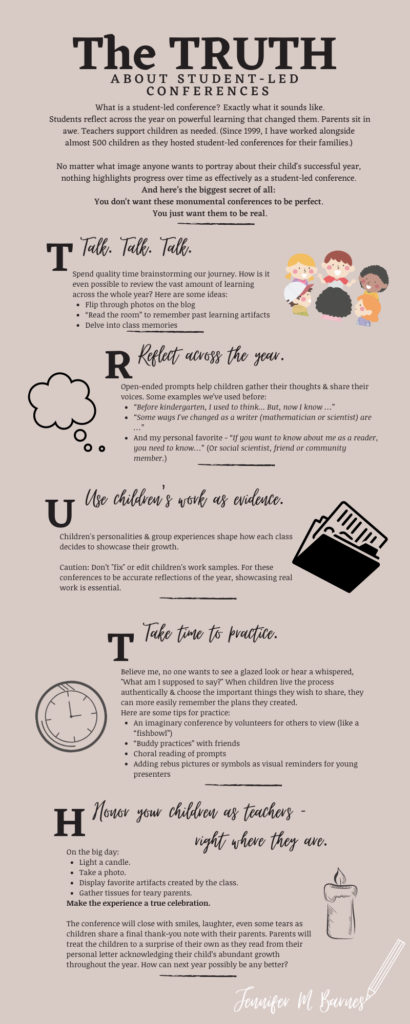
The Afternoon Before the Big Day
Invite the children to help you set the table.
- Write a “welcome” sign.
- Display the class candle.
- Gather special class keepsakes and artifacts relevant to all children – their art quilt, their favorite chapter book, their collaborative research.
- Set the timer on the table so kids understand there’s only a bit of time.
- Maybe even a tissue box? (Even kindergartners smile and shake their heads as you pull this item out. Several always giggle, “My mom is gonna need those!”)
- Be sure the children’s materials are at the designated area.
- Finally, if there’s enough time, consider creating a personalized “thank you” note from the child to the parents. One of the highlights, written on school stationery, and signed by the child for the parents.
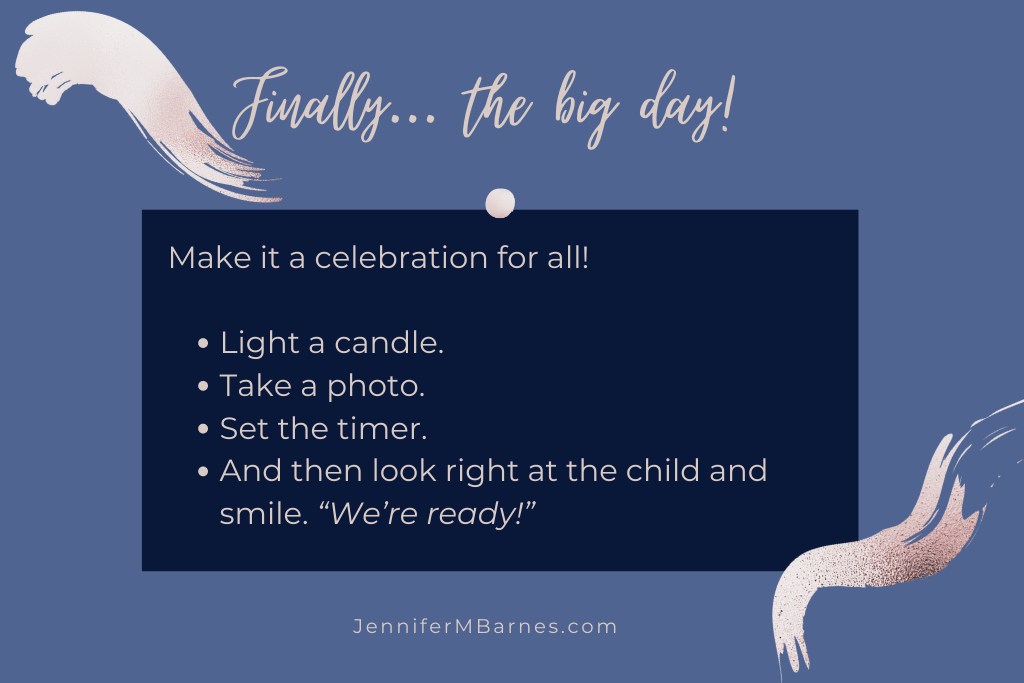
Just in Case…
- If a chld hesitates and appears so nervous, just encourage them to take a deep breath along with you. Then launch right into their familiar, sing-song phrase, “If you want to know about me as a scientist, you need to know…” Your teacher voice can drift out as the kindergartner more confidently takes over.
- If for any reason a parent tries to take over the conference to talk about something else, politely point to the timer and reiterate that the child has planned for the entire time – and that you’ll be happy to follow up with their emailed request for a conference at a later time.
The Conclusion
At the end, you’ll all feel like clapping and cheering – and you might even be crying! It’s the perfect time to share the thank-you note. Ask the parents if they have anything they’d like to quickly share. (If you invited them to bring a special note to read to their child, now’s the time to do it as well. The children all are mesmerized during these moments of full attention on them. If you’re running short on time, invite them to sit on the sofa right outside in the hallway and finish reading their letter together.)
Finally, end with hugs all around, praises, and a candy kiss. Then invite the child to blow out the candle, ending their very first student-led conference ever!
After the Conferences
- Sigh deeply.
- Share the photos.
- And celebrate a couple of days yourself!
Such difficult work – but so incredibly worth it! Savor these days. Just wait until you see how all that hard work helps you keep momentum for …
The Next 6+ Weeks!
To make the learning last even longer, simply take all the thoughts generated by the children on those charts. Type out one subject area each week and publish on your classroom blog.
- Parents are always interested to see what other children consider their most significant accomplishments during this same period of time.
- Incoming student teachers, colleagues, and your administrators find them enlightening to read.
- They’re the perfect way to ponder your long-range plans and help set goals for the remaining months of the year.
Your children and their families will have generated some goals of their own for the remaining time in the year. Be sure to check your notes to see the learning you want to capitalize on. Take a deep breath – and know you have done magnificently!
I know that was a pile of stuff! But, if you’ve got any questions about student-led conferences after this blogpost, the movie, the infographic, and the couple of podcast episodes, please be sure to drop them here. Or if you have favorite memories of your own about special student-led conference moments, we’d love to hear them! Drop them here, too. As you can tell, it’s one of my favorite topics.
